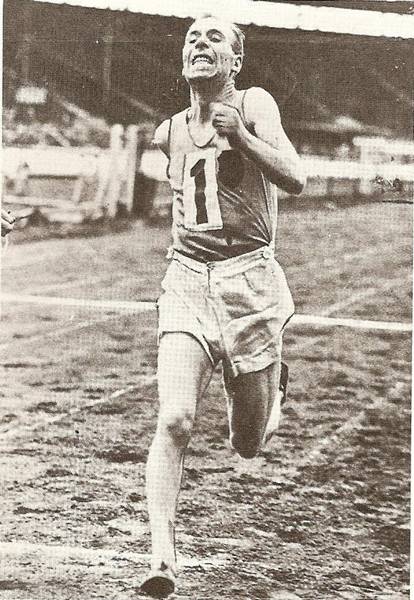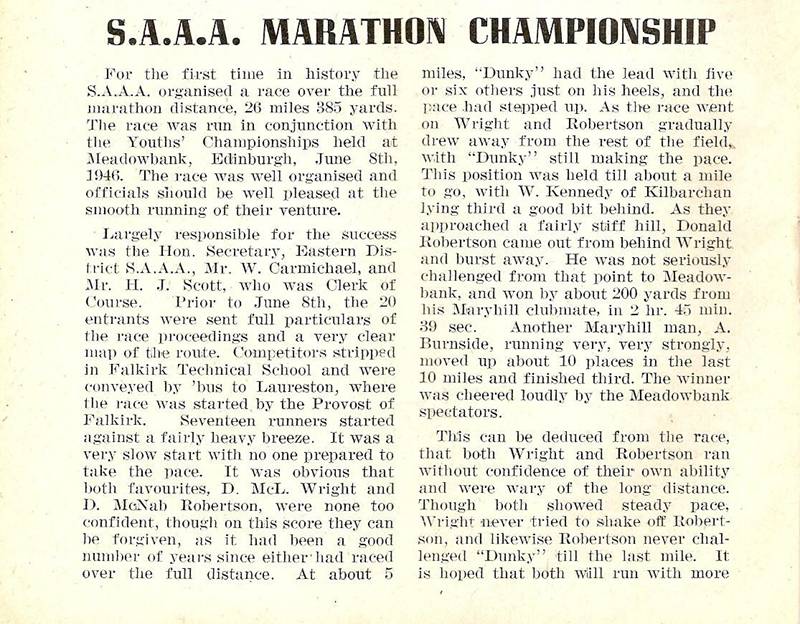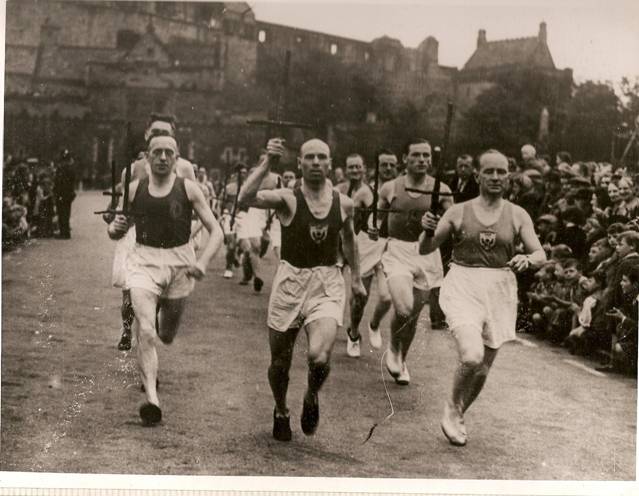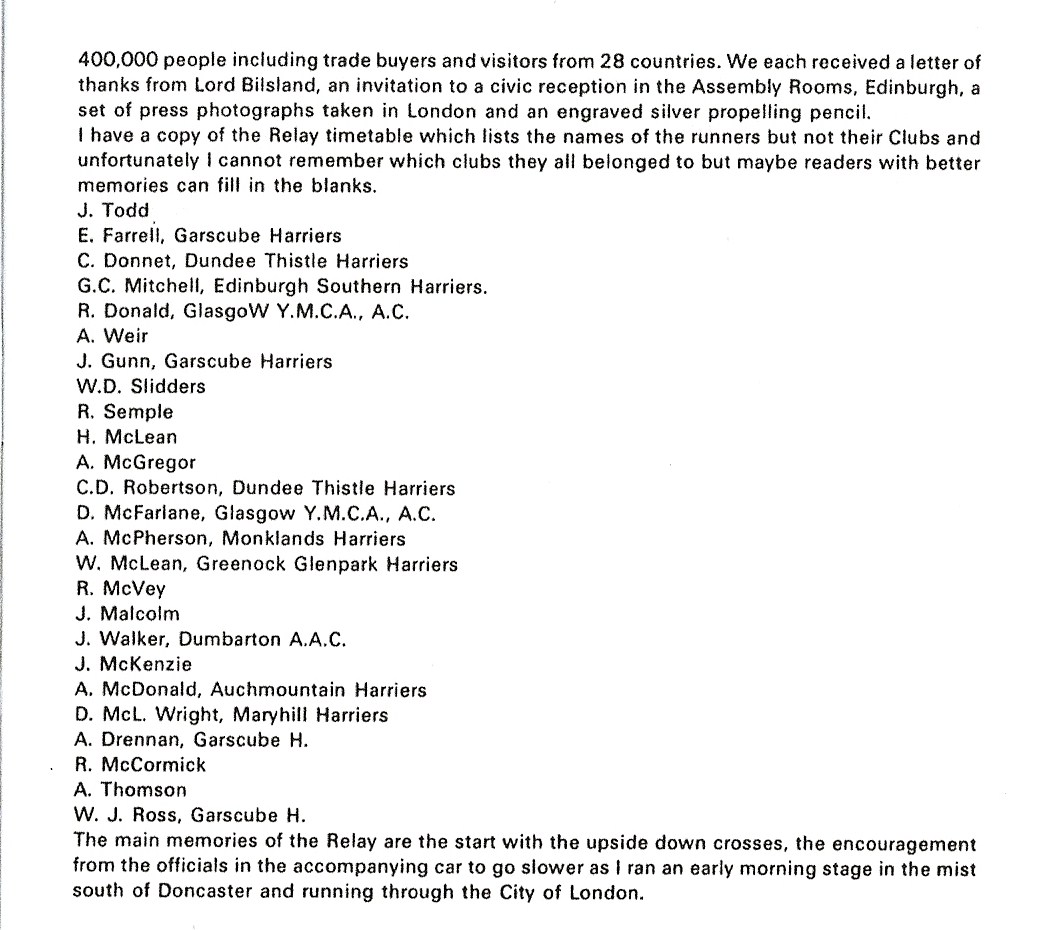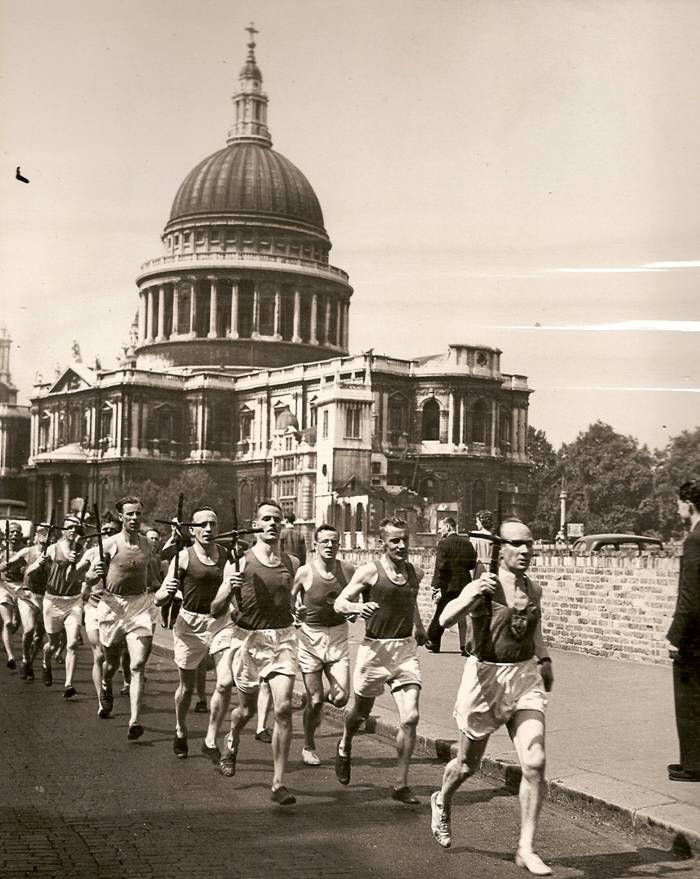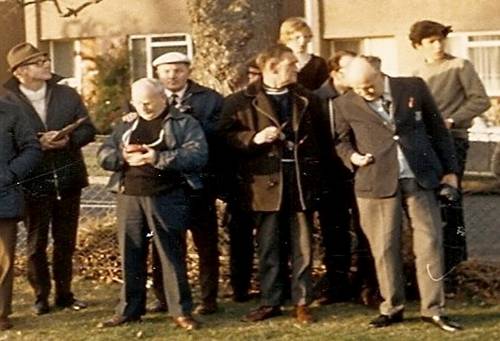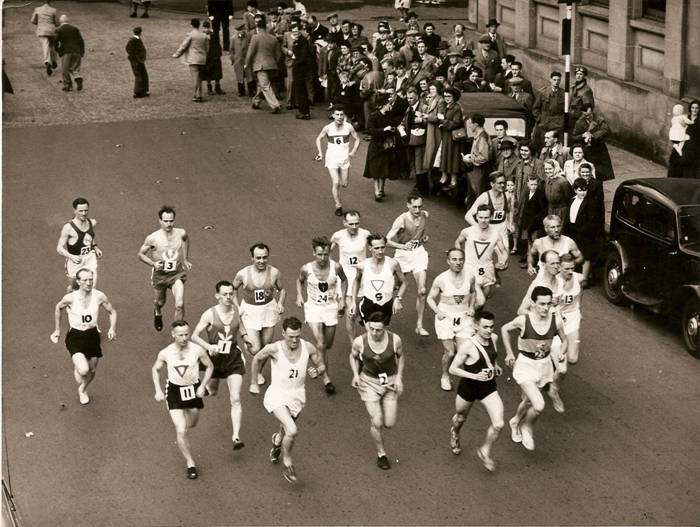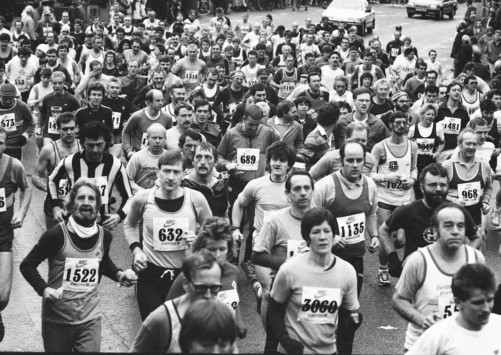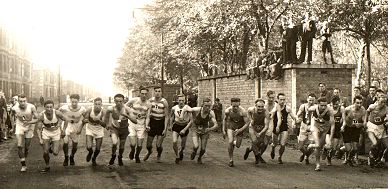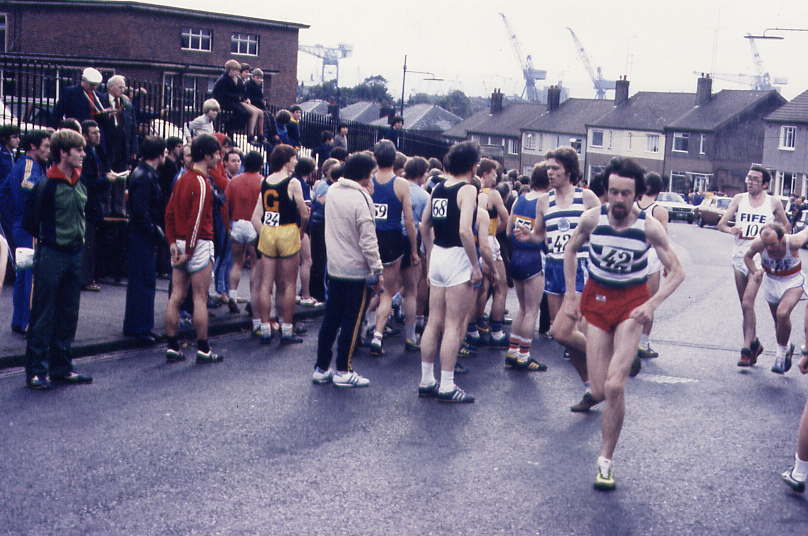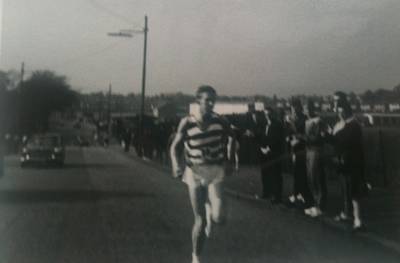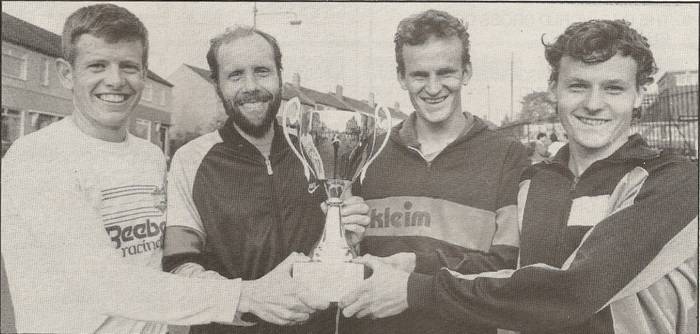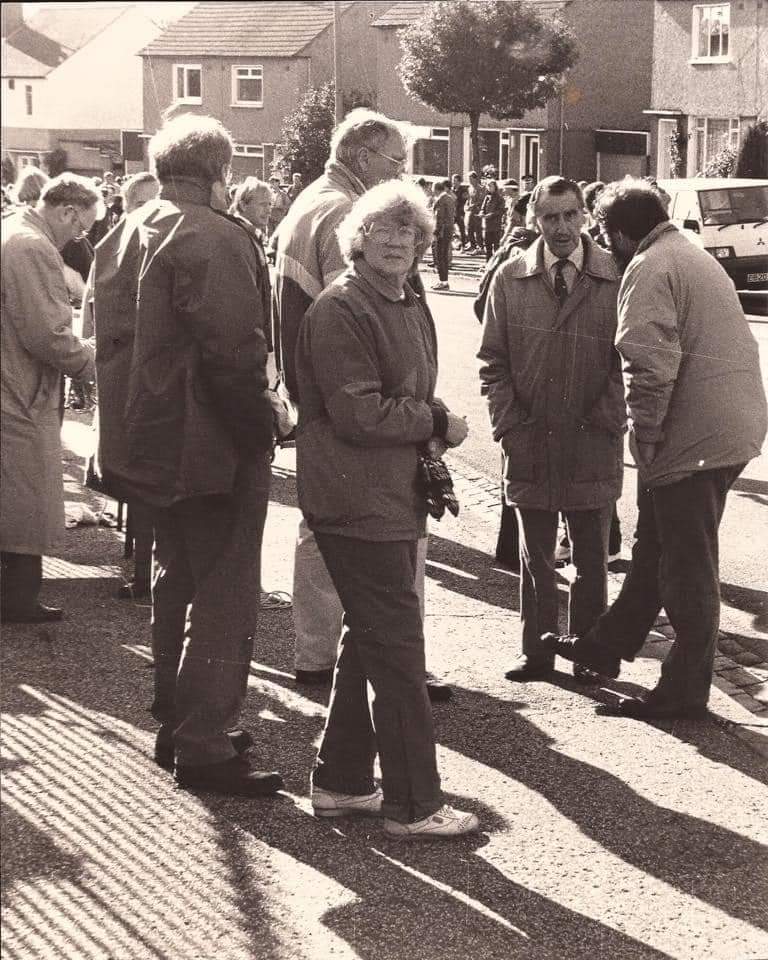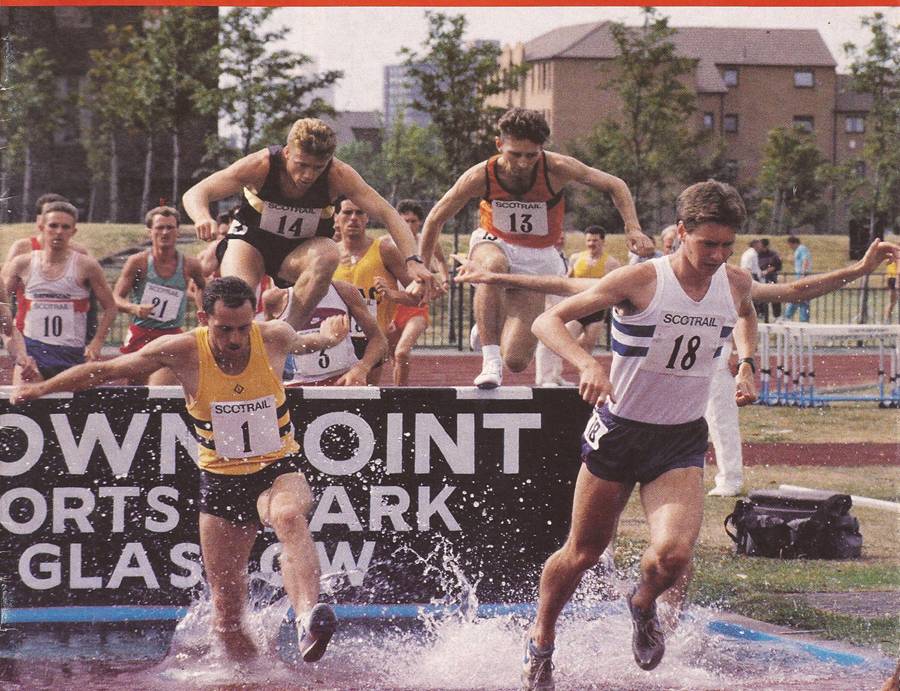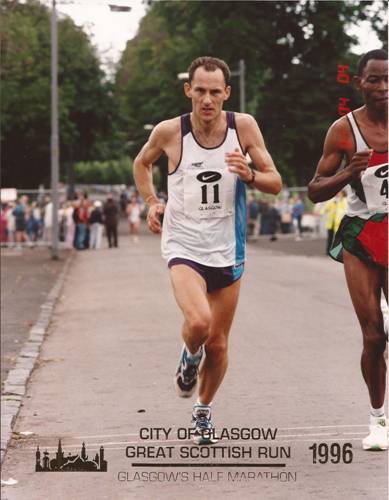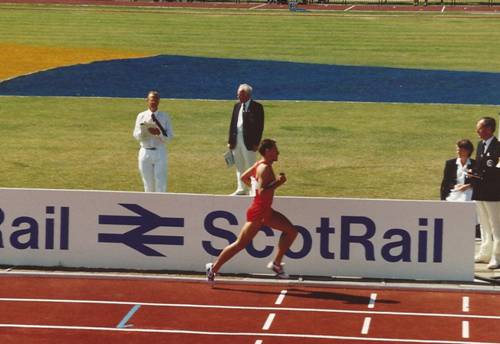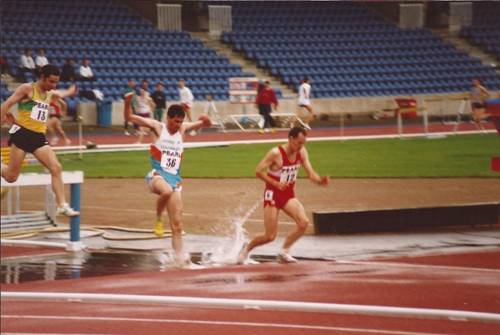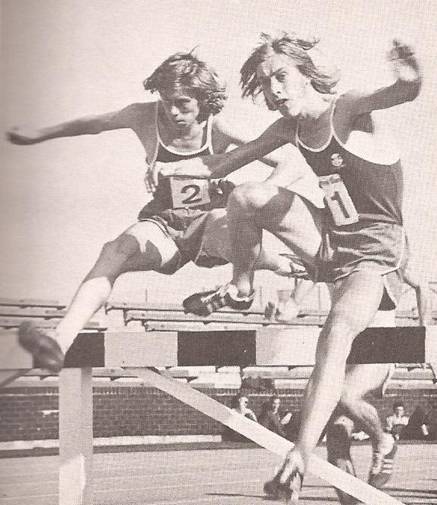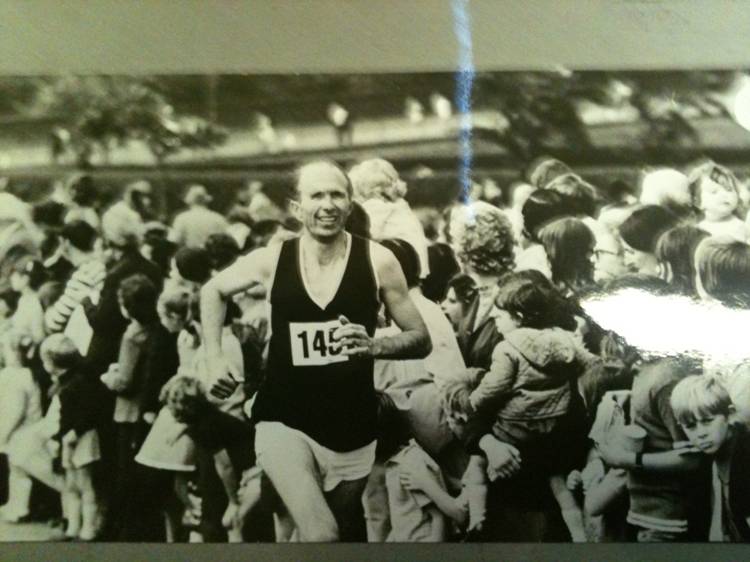
Bert McKay running in the Coatbridge 5 in 1973
Bert McKay says that he never considers himself a long distance runner, seeing himself more as a half-miler/miler. The cross-country was to get fit for the track and also, having Andy Brown as a team-mate there was no way he could escape representing the club in the Edinburgh to Glasgow Relay, the National Cross-Country, etc. Another reason for competing in road and cross-country was that there was no track in Motherwell so the roads and country were their only training facilities. He does go to say that he grew to love road and cross-country and the rivalry between the various clubs. I’m including him the ‘Milers’ section because I agree that that is where he should be. His range was wide from 880 yards to 10 Miles and he competed seriously almost every year in team races at Two and Three miles on the track and in all the cross-country relays and championships. Nevertheless he did have some very good races against top milers such as Graham Everett and Jim McLatchie – he even paced Graham through the first mile of an attempt on the Scottish Two Miles record in 1965. Motherwell had a lot of very good middle and long distance runners – men like Alex Brown, Ian McCafferty, John Linaker and others – but like many another, I regarded Bert as the most senior in the club probably with the exception of the legendary Andy Brown.
Bert was among the best respected men in the endurance running world – appearing in the Scottish track ranking lists 26 times between 1961 and 1972, winning four SAAA Championship medals in addition to his honours on other surfaces, he collected the scalps and beat the times of most of the more celebrated runners of the day including Lachie Stewart and Fergus Murray at one time or another as we will see below. Bert is a runner who must be included n any collection of endurance running profiles. His personal best track times are in the table below.
| Distance |
Time |
Ranking |
Year |
| 880 yards |
1:56.3 |
17 |
1962 |
| One Mile |
4:08.7 |
3 |
1962 |
| Two Miles |
8:57.2 |
3 |
1961 |
| Three Miles |
13:56.6 |
6 |
1964 |
| 5000m |
14:24.4 |
15 |
1969 |
| Six Miles |
30:37 |
|
1969 |
| 10000m |
31:30 |
26 |
1972 |
| 10 Miles |
51:23.0 |
3 |
1969 |
Bert McKay (Date of Birth 13/12/35) first appears in the results in 1957 as a Senior athlete. In the Scottish National Championships at the start of the year he was fifty seventh and the team was tenth. Although he almost certainly raced during the summer, we next meet him in the winter of 1957. At the start of the winter, Motherwell were not in the first six at the McAndrew but we note that the following week when Motherwell wn the Scottish YMCA relay title, the team included J Poulton, W Marshall, R McKay and T Scott with McKay being third fastest of the team. A week later in the Lanarkshire County Championships, the team was third with the same runners but this time Scott and McKay shifted positions and Bert was second fastest of the quartet. Unfortunately the team was unplaced in the District Championships. In November that year he ran in his first Edinburgh to Glasgow Relay on the very challenging second stage and, like many excellent runners thrown out cold on to that stage, failed to do himself justice and dropped from second to fifth, but the team was not able to hold that position and finished tenth. There were few results available after this but after a full winter’s work, Bert was forty ninth in the National of 1958 and this time the team was up to sixth. On 24th May he won the YMCA half mile championship in 2:01, Andy Brown won the Mile in 4:39.4 and JH Linaker (Kirkcaldy YMCA) won the Junior Mile in 4:40.1. He then appeared at the West District Championships where the Mile was won by Graham Everett who had been racing all over England as part of his quest to become the first Scot under four minutes for the mile. The report in the ‘Herald’ said RW McKay (Motherwell YMCA) held Everett for fully three quarters of the distance and recorded 4 minutes 12.2 seconds.” At the Lanarkshire Police Meeting on 7th June at Shawfield he won the Mile off 30 yards from clubmate AH Brown (25 yards) in 4:18.5. It is fair to assume that he ran in the SAAA Champiionships and was unplaced and he eventually ended a fairly good summer with second behind Graham Everett in the Invitation Mile at Cowal in late August after Donnie McDonald had towed the field round to half-distance in 2:01.4 before Everett took over to get to three-quarters in 3:04.6. The wind slowed him thereafter and his time was 4:07.5 with no time being reported for Bert.
The team was sixth in the E-G in November 1959 but unfortunately the records, even on Ron Morrison’s excellent statistical archive on his website, do not give the Motherwell runners but we can safely assume that Bert would have been a key man.. Bert started 1959 with a run in an Invitation Track Race over Two Miles. Won by Graham Everett with Des Dickson of Bellahouston third, Bert was third to finish and Motherwell finished second team with Andy Brown fourth and John Poulton fourteenth. When it came to the Nigel Barge four and a half mile road race two days later, the Motherwell team was beaten by Bellahouston and Bert was third counting runner in sixteenth position. Despite Andy Brown’s second place, the team was unplaced in the District Championships two weeks later at Renton outside Dumbarton. By the National in 1959, having been out of the results for several weeks, both Bert and the team had improved on 1958’s results – he finished twenty eighth and the club was fifth. The summer season started in May with lots of triangular matches – Victoria Park v Bellahouston v Shettleston, Shettleston v Garscube v Teviotdale, for example and various permutations of University fixtures. Then came wee out of the way meetings to warm the runners up and the actual racing started at the end of May with the District Championships. In 1958 Bert had been second to Graham Everett in the Mile at the Districts and in 1959 his first outing was in the YMCA Championships at Larkhall a week beforehand – he won the 880 yards in 1:58.7. At the Districts, with Everett racing abroad, he took the lead early on but Bill Kerr of Victoria Park had a real go at catching him. Didn’t quite manage it and Bert won in a slow 4:22.7 – more than ten seconds slower than the previous year. One of the frustrating things about looking back at newspaper reports is that they often don’t tell you more than the bare minimum of information about athletics events and although it is certain that Bert raced frequently, the next appearance is in connection with the West v East at the end of June. I quote from the “Glasgow Herald: The mile developed into a duel between RW McKay and G Stark. Stark closely followed McKay for most of the race and showed superior speed down the finishing straight, winning by less than two yards.” No time was given for Bert in the report and the results only gave the winner’s name. Nevertheless it was clear by now that Bert was considerably good. Stark was the National Mile record holder and to lead him for most of the race and then be beaten by only a yard and a half is good running by anyone’s standard. He met up with Stark again at the start of August and the race report reads as follows: “The principal event at Carluke Rovers open sports meeting was the invitation one mile short limit handicap in which the Scottish record holder G Stark (Edinburgh Southern Harriers) was running from scratch. At the end of the first lap, Stark was just behind R McKay (Motherwell YMCA) and J More (Kilmarnock) who started from 10 and 15 yards respectively. In the meantime however, the Scottish steeplechase champion, T O’Reilly, off 35 yards, was setting a good pace over the seven lap course and by half distance it did not look like Stark would catch the leaders. Soon afterwards, McKay and More left Stark and he had to be content with sixth place – 6.2 seconds behind O’Reilly the winner.” Unfortunately the report does not say who were second, third, fourth or fifth! So we don’t know from that where Bert finished or what his time was. The winner was 4:19.2, and by simple arithmetic we get 4:25.4 for sixth place.
Bert turned out on the straight head-to-head race that is the first stage and was eleventh in a team that placed fifth. In the National in 1960 he had dropped from the past year’s position to seventy third but the team had by now moved up to fourth. Summer 1960 started according to the reports later than usual. It was not until 11th June at the Glasgow Police Sports at Ibrox that he appeared running in the Mile where he was second, one place ahead of Mike Ryan from St Modan’s. He did not feature in the National Championships or the District Championships as far as the Press reports were concerned. A summer best described as quiet. So it was into the 1960/61 season in October.
On 1st October 1960, Motherwell was third behind the Shettleston winning team with Bert McKay on the first leg running a time of 15:35. A week later he ran the first stage in the Lanarkshire County Relays and handed over a lead that the club held while turning in the third fastest time of the day. On 29th October, after David Simpson had a good run on the first stage of the Scottish YMCA Relays Bert ran on the second stage for the club team which won by almost three minutes. Came the big one, the Edinburgh to Glasgow,, he was again on stage one and this time was eighth with the club again finishing fifth. In the National at the start of 1961 he did not run and the team did not finish a full six scoring runners. That summer Bert was almost an ever present in the club team at all the two mile team races and turned out in in the championships without winning a medal. There were, however, several notable performances in summer, 1961, and the first of these came at the start of May when in what was called a ‘Grading Meeting’ at Seedhill Track in Paisley the result of the Mile was a win for Graham Everett from Bert McKay and Mike Ryan – then later at the same meeting the steeplechase resulted in a win for Bert McKay in 10:48.8. This was followed by the West District Championships on May 7th where he won the Mile and lifted the scalps of Jim McLatchie and Mike Ryan when winning in 4:17.3 On 8th July at Pitreavie, running for the SAAA against an Atalanta team, the report for the Mile read R McKay (Motherwell) and KD Ballantyne (Edinburgh Southern Harriers) covered the last 20 yards of the mile almost together and finished in the same time, 4:17.3, but McKay was judged to have won.” Having shown his strength by the double at Seedhill, he went even further in June. In the Glasgow Police Sports, Graham Everett set a new Scottish record for the Two Miles on the good cinder track at Ibrox. I’ll just quote the ‘Glasgow Herald’. “Everett was taken along at a merry pace by R McKay (Motherwell) and both were well ahead of the field at halfway in in the fast time of 4:14.5, too fast as Everett admitted afterwards. It was clear that if this pace were to continue the all-comers record would be broken. Unfortunately McKay was unable to carry on having fallen out more or less exhausted after one of his best mile times. Everett was alone thereafter, but his time of 6:31.4 for a mile and a half beat T Riddell’s native record and JJ Barry’s all-comers record. He slowed over the last half mile and lost his chance of beating the all-comer’s record of 8:45.6 but the time of 8:48.6 beat his own best Scottish record by 1.8 sec. …………………… McKay made a fine recovery after his exhaustive effort in the Two Miles and won the mile in 4:08.3 from 40 yards.” Bert said that it was a deliberate attempt at pace-making for Graham, because he thought he could get the two miles record. After he dropped out he could hear Andy Brown cursing him as he passed because they could have won the team race. It had been a quite remarkable season at the end of which he was in the ranking lists for five events:
| Year |
Distance |
Time |
Ranking |
| 1961 |
880 yards |
1:57.1 |
19th |
| |
One Mile |
4:13.8 |
6th |
| |
Two Miles |
8:57.2 |
3rd |
| |
Three Miles |
14:14.6 |
11th |
| |
Six Miles |
30:27.6 |
7th |
The McAndrew Relay race on 7th October 1961 had Bert McKay hand over a lead to David Simpson that tea mates John Linaker and Andy Brown saw translated into a good victory. The same quarter ran in all the short realys that year and Bert handed a lead to the team at the end of the first stage in the Lanarkshire Championshps (won by 600 yards), the Scottish YMCA Championships, the Midlands Championships (won by more than two minutes and then in the Motherwell club time trial for the Edinburgh – Glasgow selection, he tied with Andy Brown and David Simpson for second behind John Linaker. Five races in the five weeks before the E-G itself on 18th November. The team in the E-G in November 1961 made up for the poor showing in the National when they finished third to pick up their first medals in the race. Bert ran on Stage seven for the first time and pulled the team from third to second with the third fastest time of the day. There was a bit of a hiatus after that until the Lanarkshire Championships where Bert was fourth behind Linaker, Brown and Everett. Into the New Year and the McAndrew Road Race was run in very tricky conditions – several football matches had been cancelled because of snow. The ‘Glasgow Herald’ said, “AH Brown mastered the rather precarious footing on certain stretches of the road and won the Nigel Barge four and a half mile road race on Saturday at Maryhill by 20 yards from J McLatchie in 23:20 – 30 seconds outside the record for the course. McLatchie was less than a yard ahead of R McKay who finished very strongly and J Linaker, another Motherwell runner, who finished fourth.” A hard fought race but Jim McLatchie’s story about it sounds good to me. “Dunky Wright approached me about running in the Nigel Barge Road Race in 1962 since I did a few training runs from Milngavie to Maryhill and back – he said that was part of the course. I never ran in road races – so I showed up anyway and was up with the leaders – the Motherwell boys – Andy Brown turned to Bert and said, “What’s McLatchie doing up here? ” Bert’s reply, “I think he’s going to kick our arses.” Andy: “He’s not a road runner.” Bert: Today he is.” On 3rd February, 1962, Bert had what the ‘Herald’ writer described as ‘the best cross-country performance of his career.’ It was in an invitation eight mile race at Cleland Estate, Motherwell. “The invitation eight-mile cross country race within the Cleland Estate on Saturday ended, as expected with AH Brown beating a club-mate, R McKay by 80 yards in 42 min 42 sec. McKay put up about the best cross-country performance of his career and this win by Brown enhanced his reputation for consistency over the past 12 years. At the end of the first lap of two miles Brown led the field of 42 runners from J McLaren (Victoria Park, McKay and Everett (Shettleston) and JH Linaker. Over the next circuit McKay moved into second place, 40 yards behind Brown and at regular intervals came McLaren, Linaker and Everett. At the end of the third lap, McKay had closed slightly on Brown with McLaren 120 yards behind him, and Everett and Linaker 40 and 50 yards farther behind respectively. This was the order at the finish but Brown had drawn away from McKay. Bert did not turn out in the Scottish YMCA championships two weeks later and they were won by Andy Brown from David Simpson. The winter ended with another fifth place in the National for the team but Bert was not running on the day.
We know Bert ran in the West District Championships in May 1962 because Jim McLatchie tells us so but he didn’t feature in the results or the reports. Let Jim tell the story: 1962, West Districts Mile race. I was in pretty good shape and told Bert I was going to run hard and he could hang on. I came through the first 880 around 2:03 – all I could hear from Bert ‘For ‘goodness’ sake, this is too fast for a beginning of the season race.’ After the race I asked him why he didn’t hang on and he said he was peaking for the Nationals later that year when we both went on to record personal bests.” He turned out in the Police Sports at Shawfield on the first Saturday in June where he was off scratch in the invitation three-quarter mile along with Willie Morrison of Larkhall.but they were both beaten by Jim McLatchie running off 5 yards. A week later and at Ibrox, he was second again, this time to clubmate Andy Brown in the Invitation Two Miles with Calum Laing (Glasgow University) in third. Another seven days and he was at New Meadowbank for the SAAA Championships where he was third in the Mile behind Mike Berisford of Sale and Jim McLatchie. Other than team awards, his first individual place after that was at Shotts Highland Games where he was third behind JP Anderson and J Hillen (both Saltwell AC) in the Two Miles. By the end of the summer (1962) he was ranked in four events the six miles having been dropped from the schedule, Best times for the year were 1:56.3 (17th), 4:08.7 (3rd), 8:58.6 (1st) and 14:03.2 (5th).
Motherwell won the McAndrew Relay at the start of October, 1962, with Bert again doing sterling service on the first stage. With one exception it was the team from the previous two years – Alex Brown taking the place of John Linaker – with David Simpson on two and Andy Brown on four. Andy had the fastest time of the day with Fergus Murray second and Alex Brown third and Bert himself had sixth fastest time. In the County Relays the following week, Andy Brown relegated himself to the second team, and running the first stage beat team mate David Simpson by 15 seconds. Nevertheless the team of Simpson, Marshall, McKay and Alex Brown won with Motherwell having the four fastest times of the day with Andy Brown, David Simpson and then McKay and Alex Brown being third equal. The B team was third behind Shettleston. Then on 20th October it was the YMCA Relays that they won with Bert McKay, David Simpson and Alex Brown building up a useful lead only to see Andy Brown going off the course because he was mis-directed. The B team of John Poulton, Willie Marshall, W McKnight and D Young won with the A team being third behind Larkhall. Bert had the fastest time of the day on that occasion, with Willie Marshall being second fastest and David Simpson third. On November 3rd the team retained their district title, this time Alex Brown ran the first stage, followed by John Poulton, Bert MacKay and Andy Brown. They really were an all-conquering squad at this time. Whatever the permutation, they were winners. The next week were club trials for almost all clubs involved in the Edinburgh to Glasgow and in the E-G, Bert showed what he had hinted at the previous year when he was third quickest on the seventh stage -this time he ran the fastest time on the stage and also equalled the course record. The team won with four of the fastest times of the day on stages four (AH Brown), five (AP Brown), six (J Linaker) and seven. As Colin Shields says in the official history of the Scottish Cross Country Union,“Whatever the Weather” the perils of a November race date were clear in 1962 when there was deep snow and cars were abandoned in Airdrie Main Street. It was on this occasion that Tom O’Reilly of Springburn said that it was not so much dedication as pure bloody stupidity! Colin’s comments were maybe more measured but no more accurate when he said “Moving up on sixth from Stage Three, Motherwell improved from then on. AH Brown improved 23 seconds on the 1957 stage record to finish third, and his young brother Alec and then John Linaker gained further places to to bring Motherwell into a 40 second lead by the end of the sixth stage. Bert McKay equalled the stage record to open a gap of two minutes over Edinburgh Southern Harriers and it was left to John Poulton to bring Motherwell home to their first ever victory.” In February Bert did well enough in the National in 1963 to win his first and only cross-country vest for Scotland. The result of the race was a win for John Linaker of Motherwell in 35:53, followed by Alastair Wood of Aberdeen in second, Andy Brown in third in 35:57 and Bert McKay fourth in 36:33.
That summer, 1963, there is no mention of him in the Western District Championships which was where he normally started the season. It was perfectly possible that he ran in the team race at Shawfield in the Lanarkshire Police Sports for the first three were Andy Brown, John Linaker and Ian McCafferty! The Motherwell team competed regularly at venues as far south as Lockerbie as well as all over the Central belt but Bert’s next win was at Babcock’s Sports in Renfrew on 17th June when he won the Two Miles in 9:08.9 with Andy Brown second and Alex Brown third to take the team title – to add to the club’s joy, John Linaker won the Mile and David Simpson won the 14 mile road race! Bert then won his second SAAA medal when he was third in the Three Miles behind Fergus Murray and clubmate Andy Brown. By the end of ’63 he was ranked in the Mile, Two Miles and Three Miles lists and was third in the SAAA Three Miles championship at Westerlands in a time of 14:26.4 behind Fergus Murray (14:01.6) and clubmate Andy Brown (14:12.8). His best times for the three events were 4:16.0 for tenth place in the Mile, 9:08.2 when finishing fourth in Glasgow in June which placed him seventh in the ratings, and 13:58.0 for the Three Miles, recorded at Pitreavie in in July. He went in to the winter running extremely well.
In the McAndrew Relay, Motherwell started off with Alex Brown who ran into third position but Bert McKay running on the second stage, not only gave the club a lead but set a new record for the course with a time four seconds faster than Lachie Stewart.. Ian McCafferty and Andy Brown made sure of the victory and the team had four of the six fastest times! A week later in the Lanarkshire Relays Motherwell had the first two teams with Bert running for the second team which finished 500 yards behind the first. Even more amazing was the club’s taking first and second places at the District Relay Championships on 26th October with Bert having second fastest time of the day, only four seconds slower than Ian McCafferty with Alex Brown in third fastest slot another eight seconds back. The winning quartet was AP Brown, W Marshall, I McCafferty and R McKay. Andy was in the second team which consisted of George Henderson, D Young, David Simpson and AH Brown. Quite remarkable when you consider the standard of the remaining clubs in the race. In the YMCA Championships a week later they were gallus enough to put Andy Brown and Bert into the second team and still get the first two places. The ‘Glasgow Herald’ for the result of the E-G said ” Motherwell Again Win Road Relay Race”. Bert was on the seventh stage of the E-G where he not only set the fastest time of the day but broke his own record for the stage set the previous year. Again Motherwell won by virtue of the fact that the middle of the relay had fastest times by their members on stages four, five, six and seven with AP Brown, D Simpson, J Linaker and Bert McKay bringing them from sixth to first over the four stages. It is difficult to argue with Colin Shields who said that they won it the hard way – it was not until the end of the sixth stage that they were in front, and he says of Bert’s contribution: “Bert McKay, having equalled the stage record the year before, bettered it by 24 seconds to establish a two minute lead and G Henderson brought them home easy winners.” In the National in 1964 he finished twenty ninth and the club closed in as third team.
That summer (1964) Bert started with a good run in the West District Championships at Westerlands, where he lead for much of the race before Lachie Stewart moved off leaving Bert in second with Andy Brown in third. Not placed in the SAAA Championships, he went on to a comfortable win in the Mile at the Strathallan Gathering in August. The scene was very different from that of the twenty first century. Local meetings played a big part of the athletics scene then – local highland gatherings (Dunblane, Strathallan, Shotts, etc), works gala meetings (Dirrans Sports, Babcock’s and Wilcox Sports, Singer’s Sports), community sports meetings, Braw Lads Gatherings, etc, etc. They were held on a variety of surfaces – good well-tended grass, poor cow-field grass, cinder and sticky-oot brick, ash, etc but these differences were over come by the men and women who ran in them. The best men raced each other week, week out. The Two or Three Mile Team race was always well supported – Shettleston Harriers, Victoria Park AAC, Motherwell YMCA, etc all turned out teams in the races and the teams were always the best that they could field. Lachie Stewart raced Ian McCafferty, Hugh Barrow, Andy Brown, Dick Wedlock, etc all summer. At the end of May, 1964, the ‘Glasgow Herald’ had the headline “R McKay’s record in the Three Miles” and read “R McKay (Motherwell) was one of the outstanding competitors at the Lanarkshire Championships at Larkhall on Saturday, winning the Three Miles in a new best time of 14 Min 11 Sec from his clubmate AH Brown. Brown was the previous record holder with a time of 14 min 37 sec, set two years ago over a heavy, wet grass track at Laigh Bent.” One week later on the last Saturday in May, he defeated Andy again for second place in the Three Miles at the West District Championships at Westerlands in Glasgow with Lachie Stewart first.. Two weeks later in the Lanarkshire Constabulary Sports at Shawfield he was again second to Lachie in the Three Miles and only one week later, he was second to Lachie again at Babcock’s Sports in Renfrew in a Two Mile Team race where he led Motherwell to a team victory. Next was the National Championships where he was unplaced and it is frustrating that only the first three are published for our reference. Omitting the whole of July, Bert’s next appearance that year was at Strathallan Highland Gathering where, as backmarker in the half mile, he came through to win. August finished off with Edinburgh Highland Games, Bute Highland Games (longest event One Mile) and Cowal Highland where he did not figure in the results. As can be seen, the races were not well spaced either, tending to come one on top of the other all summer. It may be of course that we have lost a lot in terms of the competitiveness of our runners because of the official demands that runners space their programme. The Scots who are doing really well just now are largely those who compete on all surfaces, all year against good opposition in the American College circuit. The surfaces were less good, but the unremitting high level competition maybe gave the runners a hardness that is missing today. He only appeared in the rankings for the Two Miles and Three Miles with times of 9:12.2 and 13:56.6 for ranking places of eighteenth and sixth. The absence from the rankings should not be taken to mean that he was running badly.
At the start of the winter, 1964, Motherwell again won the McAndrew Relay at Whiteinch with Andy Brown finishing second to Hugh Barrow of Victoria Park (fastest time of the afternoon) before Bert brought them into first place which was held by Ian McCafferty and Alex Brown. On 10th October, the club retained the Lanarkshire title with Bert running the final lap. In the Districts the club won the title for the fifth consecutive year with Bert on the third stage. He lined up at the second stage of the E-G where he dropped from first to third in the team that won thanks to four fastest times on stages four to seven (Brown, Simpson, McCafferty and Wedlock). The club was undoubtedly the strongest in Scotland and when they won the Nigel Barge team race in January 1965, Bert was not in the counting team who had three in the first six finishers. In the National in 1965 he was fourteenth with the team in fifth.
In summer 1965 Bert started as usual with the West District Championships, this time at Ayr, and finished third in the Mile behind Hugh Barrow and Ian McCafferty. Bert did not appear in the results for any of the other competitions in May or June, not even the Scottish Championships in Edinburgh – at least not in the published lists with only the winner being noted in some. His summer seemed to finish with the Shotts Highland Games at the start of September where he was second to Ian McCafferty in the Two Miles. However at the end of the summer he again ranked in three events – the Mile, Two Miles and Three Miles with times of 4:11.4, 9:00.6 and 14:13.0 to be ninth, eighth and twenty second respectively.
Season 1965-66, they won the McAndrew (Brown, Brown, McKay, McCafferty), the Lanarkshire (with Andy Brown and Bert McKay in the B team which finished second), the Scottish YMCA Championship relay st Motherwell with their ‘older members’ in the A Team (McKay on the second stage turned a two second deficit into a 500 yard lead!) and the Midland Relay Championship. The report in the Glasgow Herald is worth repeating here: “Motherwell can never make their lead big enough. Not content to win, they seem to want to blast the opposition off the course. They had a better start than usual when AP Brown handed over in second place – two or three places higher than was expected – behind J Brennan (Maryhill) who surprised most by being third fastest throughout the day. R McKay was not long in going ahead for Motherwell on the second lap, and from that point on interest in Motherwell became academic. What is worth writing is the magnificent running by I McCafferty through the three fields heavy with mud on the east side of Home Steads Farm. While all around were floundering, he gave the impression of of skating freely on the surface with his short business-like stride.” They won from Shettleston by two minutes and nine seconds. In November he was back on the seventh stage for the fourth time and held his second place in the squad that finished second. In the National in 1966, he is clearly well placed in a picture in ‘Athletics Weekly’ but does not appear in the results.
Opening his season with a win in the YMCA 880 yards championships in 1:59.5, and in the West District Championships at Ayr Bert finished third behind Hugh Barrow (winner) and Ian McCafferty. The Motherwell runners took part in most events but the next sighting of Bert McKay in the results columns was at the Lanarkshire Constabulary sports where he was second in the open half mile, no doubt after taking part in the Two Miles invitation. By the end of the summer of 1966 he was ranked fourteenth in the Mile with 4:11.0 in Glasgow in June but this was his only appearance in the rankings for the year.
The ‘Glasgow Herald’ reported consternation on the faces of Motherwell officials at the McAndrew Relays, in 1966, when Ian McCafferty failed to turn up. The reshuffle meant Willie Marshall was pulled into the team and sent out on the first stage. He handed the baton over to Bert in twenty first position and the reporter felt all hope of a win evaporated. Bert pulled the team up to ninth and sent off Alex Brown who picked up to fifth and Andy Brown came home in third place. A week later and again McCafferty failed to show up while Bert McKay was not able to run either in the Lanarkshire Relays. The team finished third. Two weeks later, and still without McCafferty, but with Bert McKay back in the team they won the YMCA Championships at Irvine with Willie Marshall, Alex Brown, Bert McKay and Andy Brown. The first paragraph of the ‘Herald’s report on 31st October said it all: “Smiles were back on the faces of Motherwell YMCA camp followers at Stirling on Saturday Their outstanding 4 x 2.5 miles relay team carried out a brutal demolition job of demolishing all who dared take away their Midland District relay title after six years custody.” McCafferty was back – the team of Alex Brown, Bert McKay, Andy Brown and Ian McCafferty was never headed. In November 1966 Bert again ran on the seventh stage of the E-G but this time dropped from second to fourth in the team that finished third.
In summer 1967 he recorded a fastest mile of 4:13.3 when finishing fourth at Ibrox in mid-August which ranked him twenty second, 9:02.6 for the Two Miles at Barrachnie in May to be nineteenth, 14:13.2 at Shawfield in June, finishing one tenth in front of Hugh Barrow, to be ranked twenty second in the Three Miles. These times and venues tell a story of running in the 1960’s: Ibrox was probably in an invitation race, Barrachnie was the Shettleston Harriers home track and was known to be almost circular and the chances are that it was a league or county match. The race at Shawfield was in a Lanarkshire Constabulary meeting and run on a softish track inside the dog track for greyhound racing was often held there in midweek. The report in the ‘Glasgow Herald’ said “AP Brown (Motherwell) at halfway never looked like catching his club mate R McKay but his recovery over the final half-mile was so remarkable that he beat McKay by 30 yards in the good time of 14 minutes 08.6 seconds.” Incidentally, the previous year he had been second in the open Handicap half mile to Gordon Sinclair of Glasgow University. He had started the season with second to McCafferty in the YMCA Championships on 20th May at Grangemouth but was unplaced in the very strong West District Championships a week later. On June 3rd however, he came out on top in a Two Miles race at Airdrie when he beat Alex Brown by 15 yards in 9:23. Seven days later the positions were reversed when Alex, well behind at halfway, won from Bert in the Lanarkshire Constabulary Sports Three Miles Individual and Team Race at Shawfield in 14:08.6 with Motherwell winning the team event. .The SAAA Championships at the end of June were of a very high standard and bert’s name did not figure in the first three in any event. No doubt he was part of the Motherwell team that won Two Miles team races at meetings in Strathallan, Bute, Cowal, and Shotts where the counting men were usually three in the first four or five.
But the big event at the end of summer 1967 was the formation of the new club of Law and District AAC. Both Brown brothers, David Simpson, Ian McCafferty and some others left Motherwell leaving them seriously bereft. From a club challenging for, and often winning, high honours, they became a struggling club which had to rebuild. Bert McKay and Willie Marshall were two who stayed with Motherwell and did more than their bit for the old club. Willie won the club trial for the McAndrew team from Bert but that was insignificant. With only one team success in October (the YMCA championships at Kirkcaldy where Andy Brown ran for the B team that finished third), Bert ran possibly one of his best ever Edinburgh to Glasgow stages in 1967 where on the very hard second stage he pulled the club from 18th to fourteenth with one of the best runs of the day, On 17th January Shettleston Harriers had an open meeting at Barrachnie and Bert ran in and won the Mile in 4:23 – not bad on that track and in January! There was no sign of him in the National Cross Country Championship and the first Motherwell runner was Peter Duffy – a useful new addition to the club.
In 1968 he was second in the West District Mile with a time of 4:20.6 and his season’s best of 4:20.2 when finishing third at Pitreavie in June ranked him only thirty first and that was his only ranked distance. The lack of Two and Three Miles times was probably largely down to not having significant teams entered in almost every meeting throughout the summer. In the West Championships he split Ian McCafferty and Lachie Stewart with the times being 4:17.4, 4:20.7 and 4:21.9.
With the Motherwell team weakened as it had been, they were not in the top ten in the McAndrew but Bert was clearly in good form judging by subsequent races. On 19th October they won the YMCA Championship Relay with a team that included Andy Brown but Bert had the fastest time with his 11:53 trumping Brown’s 12:15. The big one of course was the Edinburgh to Glasgow and again Bert was on the second stage. Taking over from Willie Marshall in fourteenth place, he ran another good race on this stage to move from that position to tenth. Unfortunately the club could not hold that and finished nineteenth – and they were out of the race. Bert’s next run in the event would be in 1975 as a member of the Clyde Valley team formed by five clubs, including Motherwell, linking up. His form in the 1968/69 season continued into the Nigel Barge Road Race on 4th January 1969 when he was fourth in what the ‘Herald’ correspondent described as “McKay moved ahead of Alec Wight on the run-in and his fourth place must be his best run of the season.” The first four were Lachie Stewart (Shettleston, 22:01), Dick Wedlock (Shettleston, 22:16), Andy Brown (Law) 22:41 and Bert McKay (Motherwell, 22:52) – only 300 yards behind the winner! He did not seem to have run in the various races for the remainder of the winter – not the Springburn Cup, the Districts, the YMCA championships or the National.
He must have kept in shape though because summer 1969 was a much better one for him with no fewer than four championship medals. Bert not only won the West District championship 5000m in 14:40.2, but was third in the Inter-Counties in 15:04.6 behind John Linaker (14:58.2) and Colin Martin (15:00.8) and third in the SAAA with 14:30.4 behind Lachie Stewart ( 14:09.6) and Dick Wedlock (14:24,4). His best time of the year was 14:24.4 which ranked him fifteenth. Then in the longest track race that he had run so far, he was third in the SAAA 10 Miles track championship in 51:23.0 behind Jim Brennan of Maryhill (50:41.2) and Bill Stoddart (Wellpark) in 50:55.0.
Summer 1970 was Commonwealth Games year in Scotland and everything was subordinated to that. Bert was thirty four and not in contention for a place at that point, and there was no Edinburgh to Glasgow in winter to look forward to but he kept training and reappeared in the rankings in 1972 when he was ranked twenty sixth in the 10 miles with a time of 51:23.0. He had of course run the distance on the road – third in the first ever Tom Scott 10 Miles road race in 51:41 and fourth two years later in 50:50 for example.
Bert did not appear in the ranking lists for any event in 1970 or 1971 but made his final appearance in 1972 when he was ranked at twenty sixth in the 10,000 metres race with a time of 31:30. The picture above shows a clearly fit Bert McKay racing in 1973. He was running in 1981 at the age of forty five and was first veteran to finish in the Tom Scott 10 Miles Road Race. This ten year period will not be covered in the same sort of detail as his running career up to 1971: apart from anything else, the archives for this are sadly lacking in detail. When it seemed to outsiders that his participation in athletics was starting to decline, it received a boost from an unlikely direction.
It was clear that Motherwell YMCA was not the force it had been, and nor was Monkland Harriers. There were several other Lanarkshire clubs with fairly small memberships and they came together to form a new club. So it was that in 1974 Bert appeared in a new vest – it wasn’t that he had left Motherwell, but a new club had been formed from five local Lanarkshire clubs. Monkland Harriers, Motherwell YMCA, L&L from Lesmahagow, Airdrie Harriers and Bellshill YMCA. The club was to be called Clyde Valley; the clubs all trained separately as before and kept club identities within their own area, coming together for racing purposes: but it meant that many very good runners came together to make a very good team. Bert was competing seriously again and incidentally passing on his hard-earned wisdom to many talented and ambitious youngsters. His own training had been reputed to be very hard and the young pretenders such as Jim Brown and John Graham came to be of a similar cast. If you use the link below, you can see what an influence Bert had on the young John Graham. The new club also had a beneficial effect on his own running as well. He had probably thought that his days of running in, and winning medals in, the Edinburgh to Glasgow Relay were over – they weren’t! The club was formed n 1974 and in November 1975 he was back on the seventh stage of the relay, holding the team’s position in third which is where they finished. Better than that, he even ran the third fastest time on the stage. In 1966 he had also run the seventh stage and had won a bronze medal with Motherwell. Missing 1976, he ran in his last E-G in 1977 at the age of forty one, this time on the third stage and saw the team drop from second to third but it finished out of the medals in seventh. Other than the E-G results it is almost impossible to find where and when he raced as a member of Clyde Valley – with a first team pool of young talented runners such as Ron McDonald, Jim Brown, John Graham, Roy Baillie and others it is not surprising that he was not in the four man teams. It is highly probable that he was racing in the B or even at times, the C team but this is not reflected in published results. The National results, almost always published in full on Ron Morrison’s website atwww.salroadrunningandcrosscountrymedalists.co.uk do not show Bert as having run there either. In addition, the newspapers stopped reporting on most of the Highland Games meetings other than Edinburgh, many of the Sports (Police, Transport, etc)had been abandoned as well. He is highly spoken of as a motivator, mentor and coach for the Motherwell group of Clyde Valley athletes and his contribution to the success of the new club owes him a debt on that side too.
***
As was said in the opening paragraph, Bert was well-liked by the other athletes and highly respected by all. For instance, Hugh Barrow who had many a race with him says “Bert was one of the really good runners of that generation, not a star but bloody good when there were a lot of good ones about! “ Jim McLatchie said, “Bert was a tough competitor, more so when the Motherwell boys were all in the same race. I enjoyed the tussles and I knew I would have to run hard if Bert was in the race. It would have been great to have sat down with him after a race and sup a pint and discuss running – but I didn’t drink back then and not sure if Bert did either.” And of course John Graham elsewhere on this website pays tribute to the training that he did under Bert’s guidance when he was a young athlete. Look it up.
Finally, although Andy Brown was indisputably Mr Motherwell YMCA, Bert was not far behind in the opinion of many. Had Bert gone to Law and District AAC, it might have been really formidable, but he didn’t, choosing to stay where he was. Be that as it may, he has had a good career in the sport and has the respect of all who knew him, raced against him or watched him in action.
